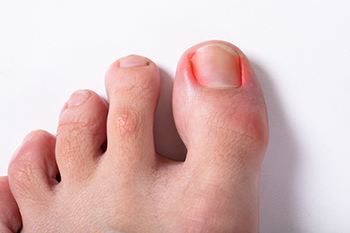
Ingrown toenails are formed when the nail grows into the surrounding skin, rather than over it. Ingrown toenails can become extremely painful, and if not attended to quickly, may become infected. People with curved or thick toenails are more likely to develop an ingrown toenail. Common causes of ingrown toenails include nails that are rounded, shoes and socks do nott fit properly, or stubbing the toe. Repeating an activity that aggravates the toe, such as kicking a soccer ball, can also lead to the development of an ingrown toenail. Trimming the toenail straight across can help to relieve the pain. If the skin around the ingrown toenail becomes red, swollen, or infected, it may be wise to consult with a podiatrist who can examine it. Draining the infected area along with administering medication are among the treatments that may be offered. In the most severe cases, surgery may be necessary. Your podiatrist also may offer post-surgical instructions to speed your recovery and prevent future occurrences.
Ingrown toenails may initially present themselves as a minor discomfort, but they may progress into an infection in the skin without proper treatment. For more information about ingrown toenails, contact one of our podiatrists of Summit Podiatry. Our doctors can provide the care you need to keep you pain-free and on your feet.
Ingrown Toenails
Ingrown toenails are caused when the corner or side of a toenail grows into the soft flesh surrounding it. They often result in redness, swelling, pain, and in some cases, infection. This condition typically affects the big toe and may recur if it is not treated properly.
Causes
- Improper toenail trimming
- Genetics
- Improper shoe fitting
- Injury from pedicures or nail picking
- Abnormal gait
- Poor hygiene
You are more likely to develop an ingrown toenail if you are obese, have diabetes, arthritis, or have any fungal infection in your nails. Additionally, people who have foot or toe deformities are at a higher risk of developing an ingrown toenail.
Symptoms
Some symptoms of ingrown toenails are redness, swelling, and pain. In rare cases, there may be a yellowish drainage coming from the nail.
Treatment
Ignoring an ingrown toenail can have serious complications. Infections of the nail border can progress to a deeper soft-tissue infection, which can then turn into a bone infection. You should always speak with your podiatrist if you suspect you have an ingrown toenail, especially if you have diabetes or poor circulation.
If you have any questions, please feel free to contact one of our offices located in Wilmington, Whiteville, and Wallace, NC . We offer the newest diagnostic and treatment technologies for all your foot care needs.
